Purnamrita Sarkar
UC Berkeley
Beyond Sin-Squared Error: Linear-Time Entrywise Uncertainty Quantification for Streaming PCA
Jun 14, 2025Abstract:We propose a novel statistical inference framework for streaming principal component analysis (PCA) using Oja's algorithm, enabling the construction of confidence intervals for individual entries of the estimated eigenvector. Most existing works on streaming PCA focus on providing sharp sin-squared error guarantees. Recently, there has been some interest in uncertainty quantification for the sin-squared error. However, uncertainty quantification or sharp error guarantees for entries of the estimated eigenvector in the streaming setting remains largely unexplored. We derive a sharp Bernstein-type concentration bound for elements of the estimated vector matching the optimal error rate up to logarithmic factors. We also establish a Central Limit Theorem for a suitably centered and scaled subset of the entries. To efficiently estimate the coordinate-wise variance, we introduce a provably consistent subsampling algorithm that leverages the median-of-means approach, empirically achieving similar accuracy to multiplier bootstrap methods while being significantly more computationally efficient. Numerical experiments demonstrate its effectiveness in providing reliable uncertainty estimates with a fraction of the computational cost of existing methods.
Spike-and-Slab Posterior Sampling in High Dimensions
Mar 04, 2025Abstract:Posterior sampling with the spike-and-slab prior [MB88], a popular multimodal distribution used to model uncertainty in variable selection, is considered the theoretical gold standard method for Bayesian sparse linear regression [CPS09, Roc18]. However, designing provable algorithms for performing this sampling task is notoriously challenging. Existing posterior samplers for Bayesian sparse variable selection tasks either require strong assumptions about the signal-to-noise ratio (SNR) [YWJ16], only work when the measurement count grows at least linearly in the dimension [MW24], or rely on heuristic approximations to the posterior. We give the first provable algorithms for spike-and-slab posterior sampling that apply for any SNR, and use a measurement count sublinear in the problem dimension. Concretely, assume we are given a measurement matrix $\mathbf{X} \in \mathbb{R}^{n\times d}$ and noisy observations $\mathbf{y} = \mathbf{X}\mathbf{\theta}^\star + \mathbf{\xi}$ of a signal $\mathbf{\theta}^\star$ drawn from a spike-and-slab prior $\pi$ with a Gaussian diffuse density and expected sparsity k, where $\mathbf{\xi} \sim \mathcal{N}(\mathbb{0}_n, \sigma^2\mathbf{I}_n)$. We give a polynomial-time high-accuracy sampler for the posterior $\pi(\cdot \mid \mathbf{X}, \mathbf{y})$, for any SNR $\sigma^{-1}$ > 0, as long as $n \geq k^3 \cdot \text{polylog}(d)$ and $X$ is drawn from a matrix ensemble satisfying the restricted isometry property. We further give a sampler that runs in near-linear time $\approx nd$ in the same setting, as long as $n \geq k^5 \cdot \text{polylog}(d)$. To demonstrate the flexibility of our framework, we extend our result to spike-and-slab posterior sampling with Laplace diffuse densities, achieving similar guarantees when $\sigma = O(\frac{1}{k})$ is bounded.
Straightness of Rectified Flow: A Theoretical Insight into Wasserstein Convergence
Oct 19, 2024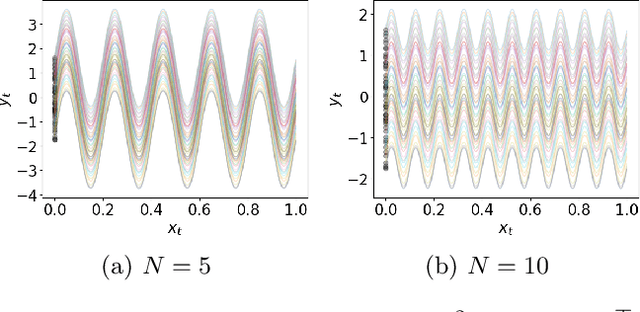

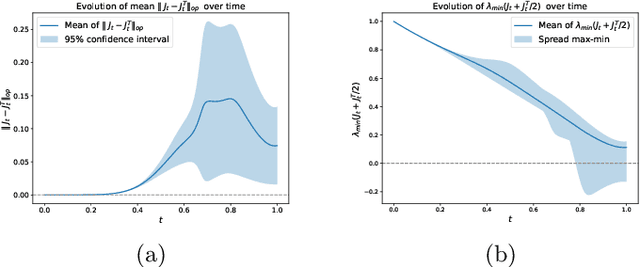

Abstract:Diffusion models have emerged as a powerful tool for image generation and denoising. Typically, generative models learn a trajectory between the starting noise distribution and the target data distribution. Recently Liu et al. (2023b) designed a novel alternative generative model Rectified Flow (RF), which aims to learn straight flow trajectories from noise to data using a sequence of convex optimization problems with close ties to optimal transport. If the trajectory is curved, one must use many Euler discretization steps or novel strategies, such as exponential integrators, to achieve a satisfactory generation quality. In contrast, RF has been shown to theoretically straighten the trajectory through successive rectifications, reducing the number of function evaluations (NFEs) while sampling. It has also been shown empirically that RF may improve the straightness in two rectifications if one can solve the underlying optimization problem within a sufficiently small error. In this paper, we make two key theoretical contributions: 1) we provide the first theoretical analysis of the Wasserstein distance between the sampling distribution of RF and the target distribution. Our error rate is characterized by the number of discretization steps and a new formulation of straightness stronger than that in the original work. 2) In line with the previous empirical findings, we show that, for a rectified flow from a Gaussian to a mixture of two Gaussians, two rectifications are sufficient to achieve a straight flow. Additionally, we also present empirical results on both simulated and real datasets to validate our theoretical findings.
On Differentially Private U Statistics
Jul 06, 2024


Abstract:We consider the problem of privately estimating a parameter $\mathbb{E}[h(X_1,\dots,X_k)]$, where $X_1$, $X_2$, $\dots$, $X_k$ are i.i.d. data from some distribution and $h$ is a permutation-invariant function. Without privacy constraints, standard estimators are U-statistics, which commonly arise in a wide range of problems, including nonparametric signed rank tests, symmetry testing, uniformity testing, and subgraph counts in random networks, and can be shown to be minimum variance unbiased estimators under mild conditions. Despite the recent outpouring of interest in private mean estimation, privatizing U-statistics has received little attention. While existing private mean estimation algorithms can be applied to obtain confidence intervals, we show that they can lead to suboptimal private error, e.g., constant-factor inflation in the leading term, or even $\Theta(1/n)$ rather than $O(1/n^2)$ in degenerate settings. To remedy this, we propose a new thresholding-based approach using \emph{local H\'ajek projections} to reweight different subsets of the data. This leads to nearly optimal private error for non-degenerate U-statistics and a strong indication of near-optimality for degenerate U-statistics.
Transfer Learning for Latent Variable Network Models
Jun 06, 2024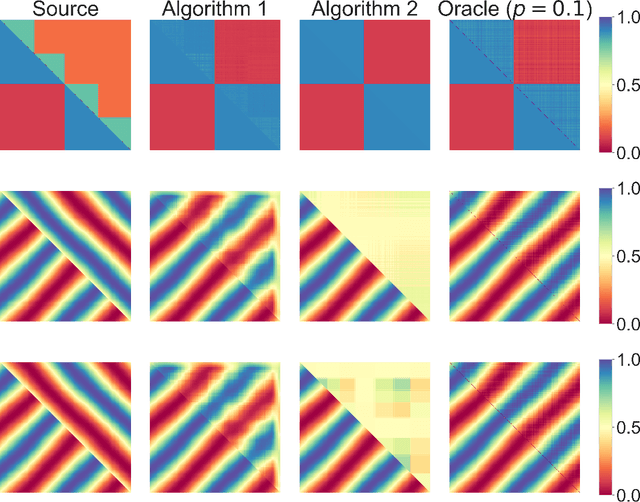
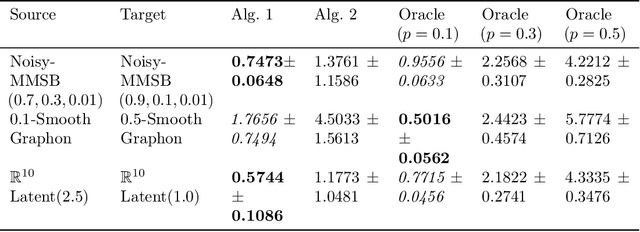

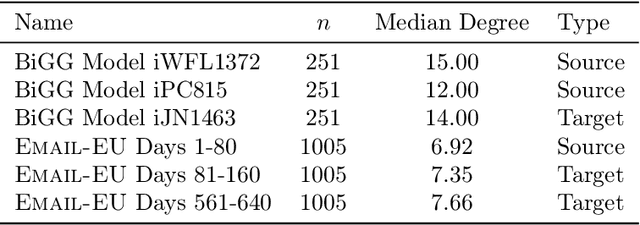
Abstract:We study transfer learning for estimation in latent variable network models. In our setting, the conditional edge probability matrices given the latent variables are represented by $P$ for the source and $Q$ for the target. We wish to estimate $Q$ given two kinds of data: (1) edge data from a subgraph induced by an $o(1)$ fraction of the nodes of $Q$, and (2) edge data from all of $P$. If the source $P$ has no relation to the target $Q$, the estimation error must be $\Omega(1)$. However, we show that if the latent variables are shared, then vanishing error is possible. We give an efficient algorithm that utilizes the ordering of a suitably defined graph distance. Our algorithm achieves $o(1)$ error and does not assume a parametric form on the source or target networks. Next, for the specific case of Stochastic Block Models we prove a minimax lower bound and show that a simple algorithm achieves this rate. Finally, we empirically demonstrate our algorithm's use on real-world and simulated graph transfer problems.
Thresholded Oja does Sparse PCA?
Feb 20, 2024Abstract:We consider the problem of Sparse Principal Component Analysis (PCA) when the ratio $d/n \rightarrow c > 0$. There has been a lot of work on optimal rates on sparse PCA in the offline setting, where all the data is available for multiple passes. In contrast, when the population eigenvector is $s$-sparse, streaming algorithms that have $O(d)$ storage and $O(nd)$ time complexity either typically require strong initialization conditions or have a suboptimal error. We show that a simple algorithm that thresholds and renormalizes the output of Oja's algorithm (the Oja vector) obtains a near-optimal error rate. This is very surprising because, without thresholding, the Oja vector has a large error. Our analysis centers around bounding the entries of the unnormalized Oja vector, which involves the projection of a product of independent random matrices on a random initial vector. This is nontrivial and novel since previous analyses of Oja's algorithm and matrix products have been done when the trace of the population covariance matrix is bounded while in our setting, this quantity can be as large as $n$.
Keep or toss? A nonparametric score to evaluate solutions for noisy ICA
Jan 16, 2024Abstract:In this paper, we propose a non-parametric score to evaluate the quality of the solution to an iterative algorithm for Independent Component Analysis (ICA) with arbitrary Gaussian noise. The novelty of this score stems from the fact that it just assumes a finite second moment of the data and uses the characteristic function to evaluate the quality of the estimated mixing matrix without any knowledge of the parameters of the noise distribution. We also provide a new characteristic function-based contrast function for ICA and propose a fixed point iteration to optimize the corresponding objective function. Finally, we propose a theoretical framework to obtain sufficient conditions for the local and global optima of a family of contrast functions for ICA. This framework uses quasi-orthogonalization inherently, and our results extend the classical analysis of cumulant-based objective functions to noisy ICA. We demonstrate the efficacy of our algorithms via experimental results on simulated datasets.
Streaming PCA for Markovian Data
May 03, 2023Abstract:Since its inception in Erikki Oja's seminal paper in 1982, Oja's algorithm has become an established method for streaming principle component analysis (PCA). We study the problem of streaming PCA, where the data-points are sampled from an irreducible, aperiodic, and reversible Markov chain. Our goal is to estimate the top eigenvector of the unknown covariance matrix of the stationary distribution. This setting has implications in situations where data can only be sampled from a Markov Chain Monte Carlo (MCMC) type algorithm, and the goal is to do inference for parameters of the stationary distribution of this chain. Most convergence guarantees for Oja's algorithm in the literature assume that the data-points are sampled IID. For data streams with Markovian dependence, one typically downsamples the data to get a "nearly" independent data stream. In this paper, we obtain the first sharp rate for Oja's algorithm on the entire data, where we remove the logarithmic dependence on $n$ resulting from throwing data away in downsampling strategies.
An Exponentially Increasing Step-size for Parameter Estimation in Statistical Models
May 16, 2022
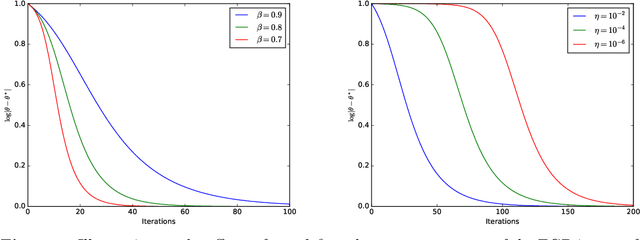

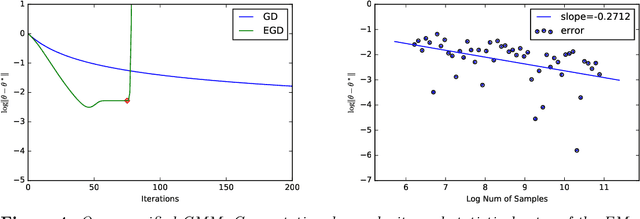
Abstract:Using gradient descent (GD) with fixed or decaying step-size is standard practice in unconstrained optimization problems. However, when the loss function is only locally convex, such a step-size schedule artificially slows GD down as it cannot explore the flat curvature of the loss function. To overcome that issue, we propose to exponentially increase the step-size of the GD algorithm. Under homogeneous assumptions on the loss function, we demonstrate that the iterates of the proposed \emph{exponential step size gradient descent} (EGD) algorithm converge linearly to the optimal solution. Leveraging that optimization insight, we then consider using the EGD algorithm for solving parameter estimation under non-regular statistical models whose the loss function becomes locally convex when the sample size goes to infinity. We demonstrate that the EGD iterates reach the final statistical radius within the true parameter after a logarithmic number of iterations, which is in stark contrast to a \emph{polynomial} number of iterations of the GD algorithm. Therefore, the total computational complexity of the EGD algorithm is \emph{optimal} and exponentially cheaper than that of the GD for solving parameter estimation in non-regular statistical models. To the best of our knowledge, it resolves a long-standing gap between statistical and algorithmic computational complexities of parameter estimation in non-regular statistical models. Finally, we provide targeted applications of the general theory to several classes of statistical models, including generalized linear models with polynomial link functions and location Gaussian mixture models.
Bootstrapping the error of Oja's Algorithm
Jun 28, 2021
Abstract:We consider the problem of quantifying uncertainty for the estimation error of the leading eigenvector from Oja's algorithm for streaming principal component analysis, where the data are generated IID from some unknown distribution. By combining classical tools from the U-statistics literature with recent results on high-dimensional central limit theorems for quadratic forms of random vectors and concentration of matrix products, we establish a $\chi^2$ approximation result for the $\sin^2$ error between the population eigenvector and the output of Oja's algorithm. Since estimating the covariance matrix associated with the approximating distribution requires knowledge of unknown model parameters, we propose a multiplier bootstrap algorithm that may be updated in an online manner. We establish conditions under which the bootstrap distribution is close to the corresponding sampling distribution with high probability, thereby establishing the bootstrap as a consistent inferential method in an appropriate asymptotic regime.
 Add to Chrome
Add to Chrome Add to Firefox
Add to Firefox Add to Edge
Add to Edge